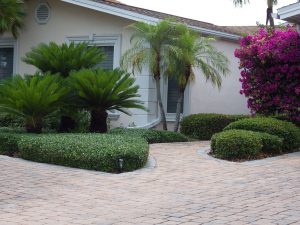 As I look around it would be impossible to know I’m in Florida by looking at the landscape plants. Nearly all of the plants used in our old-style landscapes are from somewhere else (exotic) like China, Asia, India, Japan, Brazil, Mexico, Australia, Africa, South America, Europe, and Madagascar.
As I look around it would be impossible to know I’m in Florida by looking at the landscape plants. Nearly all of the plants used in our old-style landscapes are from somewhere else (exotic) like China, Asia, India, Japan, Brazil, Mexico, Australia, Africa, South America, Europe, and Madagascar.
These old-style landscapes are very hard on Florida. They can use huge amounts of water, and depletion of our aquifers is serious and worsening. Fertilizers, pesticides, and bacteria runoff or leach into our water causing pollution. Lost are the critical living and breeding sites for our native plants and animals. The number of threatened and endangered plant and animal species are increasing due to pollution, predation, and loss of habitat. Use of exotic plants leads to the introduction and establishment of destructive invasive species.
Meanwhile our native plant habitats provide many important functions. They clean our water and air, generate food, control erosion and sediment, decompose and treat waste, provide hazard (flood, drought, etc) relief and regulate the climate. They don’t require equipment that uses fossil fuels, no pipes or pumps are needed to deliver water, no fertilizer is required. They run on sunlight, soil, air, water and a network of living things. They provide food and housing and the ability for all the plants and animals of this habitat to live and reproduce.
For our future landscapes to be maintainable without harm to Florida they will need to thrive within their environmental limits. The underlying site conditions of the property will provide the information for selecting the right plants to thrive. In Pinellas County we have three major types of habitats: coastal strand, sandhill, and flatwoods.
Understanding the types of native habitats and their different site conditions provides the basis for choosing plants that thrive in them. The coastal strand habitat is along the shoreline. Plants here need to be salt and wind tolerant, prefer alkaline soils, and most will need to be drought tolerant too. The sandhill habitat is high and dry with poor soils. Plants must be very drought tolerant to survive here. Flatwoods can go from very dry to sopping wet, so plants here must be very adaptable and able to tolerate drought and flooding.
Once you know which habitat your property best mimics it makes it easy to choose the right plants. There are “sets” of plants that work in their given habitat and some generalist plants that thrive in all of these habitats. Native plants are considered specialty plants so you won’t find them in the big box stores. Ask your local plant nursery to order them for you, or visit our two native plant nurseries – Wilcox and Twigs & Leaves.
What you plant, matters! Start replacing those old-style exotic plants with new native plants. The earth and all its animals will thank you, and so will I.
There are many resources available to help you find the right plants. The University of Florida Extension provides a free Lawn and Garden Help Desk Monday-Friday from 8 AM to 5 PM. They are located at 12520 Ulmerton Road, Largo, FL. Some excellent books include: “Landscaping for Florida’s Wildlife – Re-creating Native Ecosystems in Your Yard” by Joe Schaefer and George Tanner; “Priceless Florida – Natural Ecosystems and Native Species” by Ellie Whitney, D. Bruce Means and Anne Rudloe; and Florida Wildflowers in their Natural Communities” by Walter Kingsley Taylor.
For classroom learning attend my class “Right Plant, Right Place by Habitat” on July 18th from 3 to 5 PM at 12520 Ulmerton Road, Largo, FL. The cost is $5.00. To register go to this link: https://rightplantjuly18.eventbrite.com
 0
0
